Introduction
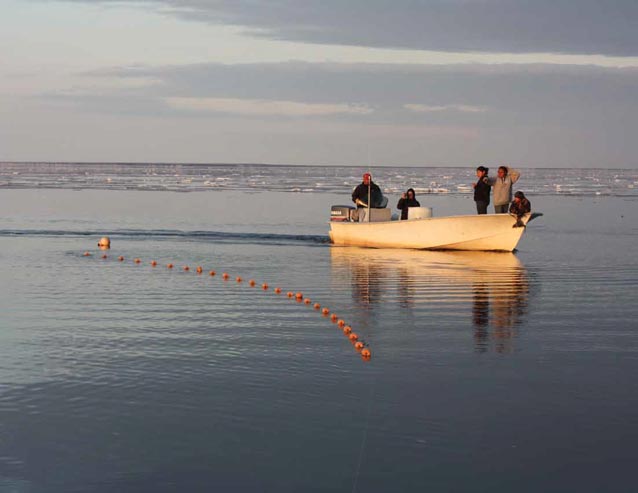
The global warming trend of the past century is amplified at high latitudes. Arctic temperatures in recent decades are the highest they have been over the past 400 years (Overpeck et al. 1997). Environmental changes observed over the last four decades suggest that the effects of climate change in the Arctic are already recognizable. These changes include melting sea ice, rising sea levels and coastal erosion, permafrost thaw, and the range extension of some fish species (Hinzman et al. 2005). Global climate change and the regional intensity of change in the Arctic have significant implications for the remote, indigenous communities of the North, who are closely tied to their surrounding environment. Residents of the Arctic recognize that regional climate has changed within living memory (Krupnik and Jolly 2002).
The complex relationships between changing climatic factors, ecosystem dynamics, and effects on fish populations raise concern for management bodies and resources users, who are searching for ways to prepare for and respond to potential changes in the distribution and abundance of key fish species and in ecosystem dynamics (Stram and Evans 2009). Few studies have specifically addressed the impact of climate change on subsistence fishing activities in remote Alaskan communities and the perceived importance of these impacts. Given the dependence of communities in northwest Alaska on subsistence fishery resources, it is imperative to better understand the current and potential impacts of climate and other cultural changes on these fisheries. Active and experienced fishers throughout arctic Alaska possess a deep body of knowledge about local fish resources and environmental interactions accumulated over generations, which we refer to as traditional ecological knowledge. This rich body of knowledge is often under-recognized and under-utilized in conventional studies of environmental change and its impact. Understanding and addressing a process as complex as climate change are improved with the inclusion of these local perspectives.
Ethnographic Investigation
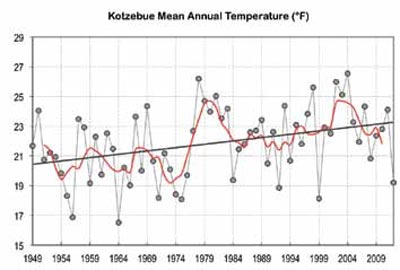
Alaska Climate Research Center, Geophysical Institute, University of Alaska Fairbanks.
Ethnographic methods provide a useful set of tools for studying and seeking to understand traditional ecological knowledge. With an emphasis on observing and participating in the daily lives of people, ethnographic research provides powerful insights into the holistic and integrated nature of subsistence practices and the factors shaping subsistence economies. With funding from U.S. Fish and Wildlife Service, Office of Subsistence Management, and the National Park Service George Wright Melendez Climate Change Fellowship, we worked in the Iñupiaq communities of Noatak, Shungnak, and Selawik in northwest Alaska to document local observations of changing environmental conditions and impacts on subsistence fishing practices. We conducted semi-structured ethnographic interviews (Spradley 1979) with local residents knowledgeable about the local environment and subsistence activities to explore knowledge about climate and ecological changes of concern for subsistence fisheries. We interviewed 17 people in Noatak, 13 people in Shungnak, and 21 people in Selawik. We guided the interview discussions by asking questions about the distribution and abundance of targeted subsistence fish, observations of species-level changes, other ecological changes, and weather and seasonal patterns that may affect fishing activities. During the semi-structured interviews we actively avoided asking leading questions about “climate change” as a broad phenomenon, but instead queried people about their observations of changes in environmental and ecological conditions over their lifetime of engaging in subsistence practices.
We also implemented a cultural consensus survey (Romney et al. 1986) in each community to assess the degree of agreement among knowledgeable fishermen about climate change observations. The consensus survey consisted of a list of 44 agree/disagree propositions that we developed from qualitative analysis of the ethnographic interviews. During the survey, we asked respondents to think about environmental conditions now compared to about 20 to 30 years ago. We focused on this time period because interview participants said that this was around the time they started noticing major changes in local conditions. In each community we worked with local leaders to compile a list of knowledgeable elders and active fishermen to survey. We surveyed 24 local experts in Selawik, 25 in Noatak, and 16 in Shungnak.
Observations of Changing Conditions
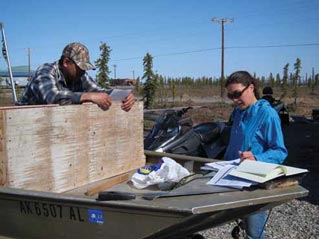
The people of Noatak, Selawik, and Shungnak possess extensive knowledge of current and historical weather conditions, ecological conditions related to important subsistence fish species, harvesting and processing of fish, as well as the complex links between these phenomena. Overall, we found consistent agreement about a range of perceivable environmental changes affecting subsistence fisheries in this region. Residents are noticing changing weather conditions, shifting break-up and freeze-up patterns, lower river and lake water levels, melting permafrost, increased river bank erosion, and changing populations of some local animal species. These changes have implications for subsistence fishing practices, such as more difficult boating conditions, unfavorable weather for processing fish, poor water conditions for fishing activities, increasingly unpredictable fish movement patterns, and increased blockage of waterways by beaver dams. We discuss these observations and impacts in more detail in the following sections, and include direct quotes from interviews in order to allow local experts to speak for themselves.
Changing Weather

Residents of all three communities perceive winters to be warmer and notice less snow during the winter months than in the past. Interview participants consistently commented that winters are now milder compared to the past and long stretches of severe cold are much shorter in duration. Eighty-five percent of survey respondents agreed that winters are warmer now compared to about 20 to 30 years ago. One person characterized recent winters as “skinny,” with warm weather, fewer storms, and low snowfall. Summer weather also appears to be changing, which has implications for water temperature and fish health. Many interview participants cited examples of uncharacteristically warm weather and the presence of soft, mushy fish and even fish die-offs in warm water bodies.
Shifting Break-up and Freeze-up Patterns
Changes in the timing and nature of freeze-up and break-up are viewed as indicators of changes in the overall weather of the region. These two events mark the end of one season and the activities associated with that season, and a transition to another season and its associated activities. In this region, spring break-up is typically preceded by a period of deteriorating ice conditions, followed by an actual ice break-up event that generally occurs over the course of many hours or a full day, and is preceeded by high water levels in local rivers and streams, which is not conducive for fishing. During freeze-up there is a period of limited travel as the formation of heavy slush ice and shore ice curtails boat travel, and people await the formation of ice solid enough to allow safe crossing of local water bodies by overland transport methods. Overall, interview participants notice that break-up is happening early and more quickly and freeze-up is happening later and more slowly, often characterized by an abnormal freeze-thaw cycle. These changes create challenges for subsistence fishing practice. Fast spring break-up limits the amount of time available for ice fishing and creates dangerous travel conditions. A late fall freeze-up creates challenges for traditional fish processing techniques, which require consistently cold temperatures. The following quotes discuss these changes in freeze-up and break-up:
Stuff is starting to change. [Break-up] comes early, comes really suddenly... It used to be a long spring, just melting slowly. Now it won’t do that. Everything just melt. The ice rot real quick and crumble… Selawik, July 19, 2010
Last few years it’s been unpredictable in the fall time... when we’re going to have freeze-up. We think it’s finally here and then it melts again. Selawik July 22, 2010
Our weather change from when I was a young kid. When we have break-up here at Noatak, we used to have real high water. Not the way we have right now. That’s low water down there. Everything changed. You can see our river right now. It’s low water. Noatak June 18, 2010
Lower Water Levels
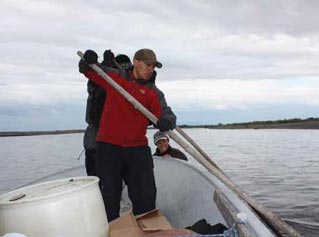
esidents of these communities constantly monitor water levels of rivers and lakes because they affect both boating and fishing conditions. High water levels are generally not good for fishing because the fish do not generally congregate and are difficult to find. When water levels drop, fish often collect in deep pools along the river channels, making them easier to find and harvest. However, low water levels can serve as a barrier to accessing certain spots by boat. Because water levels play such an important role in subsistence activities, new patterns of water level fluctuations are perceived to be particularly significant phenomena linked to climate change. In all three communities, interview participants consistently noted lower water levels during the open water season. In support of this observation, 89% of survey respondents agreed that river water levels are lower now compared to 20 to 30 years ago. Low water causes much difficulty when boating. We heard about innumerable incidences of boats hitting the bottom and receiving costly damage. People also noted that they are now often unable to reach where they would like to fish because of low water levels.
I think from being too hot last few years, there’s less water. We used to be able to boat in and out and [now] we hit ground. We had to pull the motors up and use poles to go back to the main river. Selawik July 22, 2010.
Thawing Permafrost
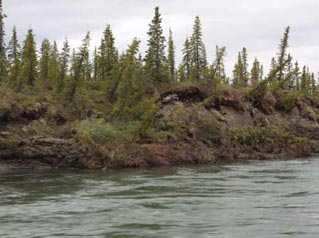
Thawing permafrost and subsequent erosion is a particularly apparent change detected by residents of northwest Alaska. In the survey, 92% of respondents agreed that permafrost is thawing more now compared to 20-30 years ago and 97% agreed that thawing permafrost affects the land, river banks, and lake edges. The rivers of this region display dramatic evidence of large thaw slumps. The nine-acre wide and eighty-foot high “Selawik Slump,” located 175 mi (282 km) upstream from the village of Selawik, is likely the largest in North America (Rozell 2009). It is not yet known how sediment from the expanding slumps may affect spawning habitats for fish.
Increasing Presence of Beaver
In all three communities, we learned that hunters and fishermen are noticing increasing local populations of beaver. In Selawik, one informant noted, “I notice that there’s tons of beaver where there hardly used to be beavers around.” Another explained, “All over they make dams. There are too many… pretty soon we going to have no more fish.” Similarly in Noatak and Shungnak, informants noted that beaver have become increasingly abundant in the area, particularly in the last ten to fifteen years. This increase is likely partly the result of decrease in hunting pressure. However, some informants also relate increasing beaver numbers to warmer weather and increasing vegetation in the region. Many fishermen agree that beaver affect local fish populations. One informant noted that “Beaver are a menace to the fish.” Beaver dams have a particularly visible impact, since many people see fish blocked behind beaver dams during periods of low water. Beaver dams also make boating increasing difficulty. The ecological impacts of increasing beaver numbers in northwest Alaska is an area requiring further research.
Conclusions
Active and experienced subsistence harvesters in Noatak, Shungnak, and Selawik consistently note a range of environmental changes linked to climate change, which have implications for current and future subsistence fishing practices. Lower water levels hinder boating access to important fishing locations. Unpredictable weather conditions challenge traditional fish processing methods. Increasingly warm fall temperatures and freeze-thaw cycles create dangerous travel conditions and limit mobility. Beaver have the potential to dramatically reshape the aquatic environment, with implications for fish health and abundance, as well as human health. Overall, we found a high level of agreement, based on cultural consensus analysis, about the observations of environmental shifts between and among Noatak, Shungnak and Selawik expert informants. As climate change research in northern ecosystems continues, it is increasingly important to include the perspectives of local harvesters, who are experiencing these changes firsthand.
Part of a series of articles titled Alaska Park Science - Volume 12 Issue 2: Climate Change in Alaska's National Parks.
Last updated: March 11, 2015
